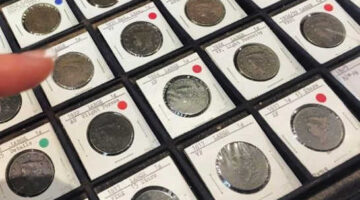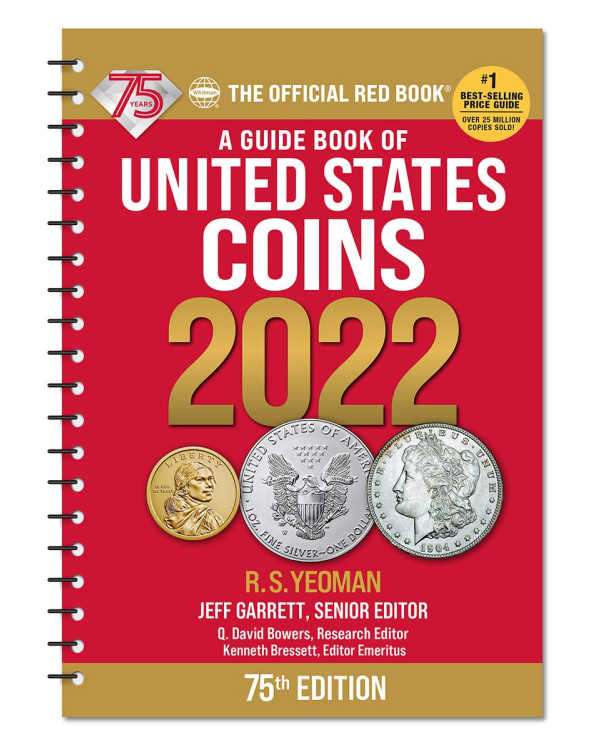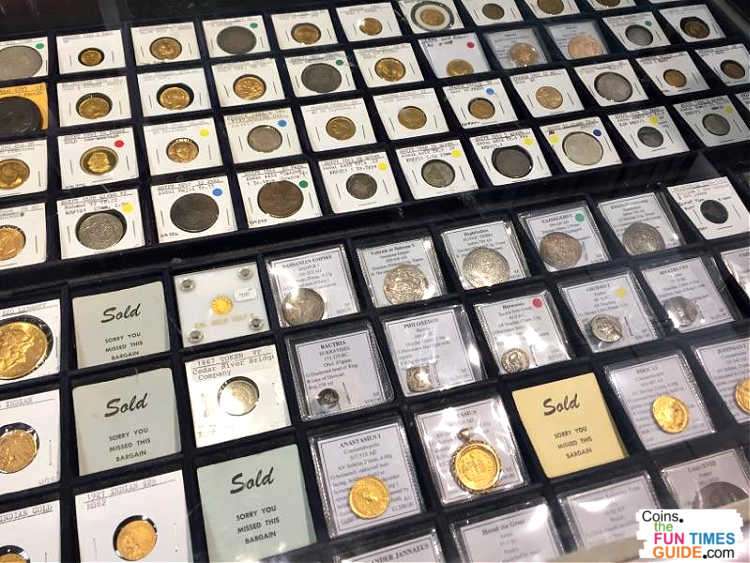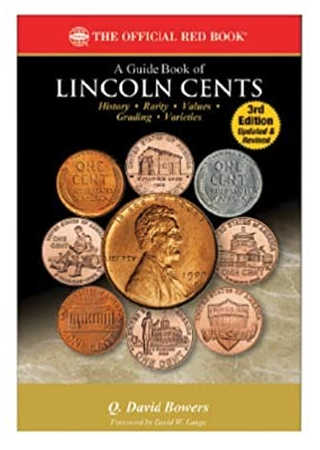It’s easy to make coin collecting mistakes — especially when buying rare and valuable coins.

I’ve made plenty of flubs in buying coins over the years — and I venture to say a fair number of people reading this article have, too. Maybe even you! (Don’t worry, no judgement here…)
Some coin collecting mistakes can be painful, especially those that pertain to buying rare, valuable coins.
I think we each have our own parameters for what the terms “rare” and “valuable” mean, but we can all agree these words describe coins that are hard to find and expensive to buy.
For that reason, we need to be extra careful about buying these pieces!
Our chances of making a risky collecting move (or even a financial blunder!) significantly increase when dealing with rare and valuable coins.
Here are 5 common mistakes associated with buying rare & valuable coins — and how to avoid them!
#1 – Not “Buying The Book Before You Buy The Coin”
There’s an old saying in coin collecting that goes, “Buy the book before you buy the coin!”
It simply means you should research whatever coins you wish to collect before you begin collecting them.
That adage by 20th-century New York City coin dealer Aaron R. Feldman (and popularized by him in 1966) could be translated by more digitally aware audiences to mean: find out more about the coins you’re interested in through websites like this one.
But the heart of the saying remains the same… do your due diligence before spending a bunch of money on coins you don’t even know about!
I’ve been researching coins for decades — ever since I got into the hobby back in 1992.
When I ventured into building a complete set of Lincoln pennies, I bought several books about the famous series — including A Guide Book of Lincoln Cents by iconic numismatic author Q. David Bowers.
Lincoln pennies have always been one of my very favorite coins, so I felt pretty confident about building this set of coins after I studied up on the basics of the series.
However, many years ago I started pursuing a gold coin type set — a large and expensive one.

I later sold it and put the money toward buying a home. I lost interest in building the set of gold coins. Not only because it became too expensive for me to complete my set the way I wanted to, but also because I didn’t feel that intimately familiar with those coins — they were beyond my realm of experience or deep knowledge.
I had become consumed with work by that point in my life and really couldn’t take the time necessary to read up on the various gold coins I was chasing after.
This led to my missing out on knowledge that could’ve helped me save money while buying the right gold coins for the set.
I later came to realize there were some scarce dates out there that I could’ve bought for the same price as the common ones. Oye veh…
#2 – Paying Too Much For Rare Coins
We all know rare coins are expensive, but at what point are they too expensive?
This is where buying the book before buying the coin would be useful, eh?
Actually, yes… And one of the informational venues you should research when trying to find out how much to spend on rare coins is a price guide.

Bear in mind, price guides are merely an indication of current market prices and aren’t the final say as to what an individual coin is worth. But a price guide like “the red book” can help tremendously when you’re trying to determine approximately how much you should pay for a standard specimen of a particular type of coin.
I’ve received a few good deals over the years — and, admittedly, I’ve also paid more than I probably should have for certain coins.
One of the most memorable times that I overpaid for a coin was when I bought a 1909-S VDB penny. It was a coin I had always wanted since I was a kid.
I probably paid $100 to $250 more for the coin than I might have paid elsewhere — but this was a slabbed specimen with nice, chocolate-brown surfaces. It was also the first time I ever paid for an item on layaway. (Looking back, I actually didn’t do too badly with that deal.)
I still have that coin today, and I’m pleased to finally have a beautiful example of a 1909-S VDB Lincoln penny in my possession. I’ll probably end up passing that coin down to the next generation — so I can’t really be too upset about overpaying a bit for a coin that I like so much.
#3 – Impulsively Buying Rare Coins
I’m sure you’ve reached for that last-minute candy bar or magazine in the grocery store checkout line, at times. Goodness knows, I have! Many times.

These little impulse buys usually set me back anywhere from from about $1 to $5. Or sometimes $10 to $15 — for one of those glossy commemorative magazines honoring the anniversary of a favorite TV show, historical event, or iconic figure.
Of course, $1, $5, or even $15 represents a far less financially hindering impulse buy than one that might cost $100, $500, $1,500, or more.
For folks who have that kind of money to toss around… more power to them. But for many of us, including yours truly, $100 is a lot of money!
Before I bought my house, I would spend $100 or more on rare coins on a whim. And I would usually end up selling them later at a loss — because I no longer wanted the coin, or it didn’t fit into my collection.
If I had bought coins in my early days with a little more purpose and thought, chances are decent that I would’ve made better buys that were more meaningful to my long-term coin collecting goals.
#4 – Buying Overgraded Coins Or Problem Coins
I’m a perfectionist. This can make my pursuit of rare coins a little more frustrating — especially when I set the bar too high for myself in buying coins that I can barely afford anyway.
It’s OK to have high expectations when you’re buying rare coins. You want to be satisfied with the buys you make, right?
However, your perfectionism is going to make buying coins difficult once you realize that it’s pretty tough to find the “perfect” coin. This is especially true if your budget doesn’t allow for buying the nicest coins around.
Granted, we can’t all own the best of the best. Then there really wouldn’t be a “best,” would there?
And it’s OK to expect problem-free coins with decent surfaces that are graded properly. That should be the case no matter what type of coin you’re buying.
The issue is that there are some coins out there that have been overgraded (unintentionally or otherwise) or that are hiding post-mint damage problems that may not necessarily jump out and present themselves to you at first.
I’ve accidentally bought several overgraded or otherwise subpar coins whose imperfections I hadn’t noticed at first, including:
- A slightly bent 1799 Draped Bust silver dollar
- A suspected counterfeit 1835 Capped Bust half dime
- A 1878-CC Morgan dollar with a significant rim ding
These were all purchases years ago that have taught me to be a little more careful before buying any coin — especially rare and valuable coins!

#5 – Selling Coins Too Quickly
I lump this particular mistake about selling coins in with the others about buying coins — because all too frequently, the purchase of rare coins is made with the sole intention of flipping it for a profit.
Oooh, the pitfalls that can come with that!…
- Rare coins don’t usually increase in value quickly enough for you to score a meaningful profit in only a few days or weeks.
- You might actually want that rare coin for your collection in the long run.
Seller’s remorse is a thing. Especially to coin collectors who come to realize only after selling a certain treasure that they let go of something special — something that’s hard to find and that they may not ever be able to get back.
A lot of collectors experience seller’s remorse when they sell rare and valuable coins. Some go to great lengths (and expense) to later buy back a certain coin that was once theirs — or at least one that’s similar.
This happened to me when I sold a nicer circulated 1799 Draped Bust dollar in the weeks after buying it for another rare coin for my Lincoln cent set.
Sometime later, I reached back out to the dealer to whom I sold the early American silver dollar to see if they still had it. I was lucky enough that the coin was still available, and I bought it back for a premium over what I had initially paid.
But in the case of the 1834 Capped Bust half dollar that my parents gave me for my 13th birthday and that I later sold to pay a tuition bill? Not so lucky there… That coin sold before I could buy it back.





